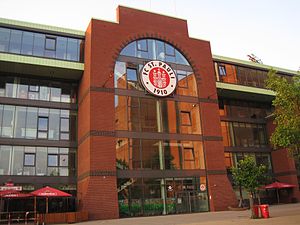Millerntor-Stadion
 |
|
| Former names | Wilhelm-Koch-Stadion (1970-1998) |
|---|---|
| Location | St. Pauli, Hamburg-Mitte, Hamburg, Germany |
| Coordinates | 53°33′16.5″N 9°58′3.6″E / 53.554583°N 9.967667°ECoordinates: 53°33′16.5″N 9°58′3.6″E / 53.554583°N 9.967667°E |
| Public transit | St. Pauli, Feldstrasse |
| Owner | FC St. Pauli |
| Operator | Millerntorstadion Betriebs-GmbH und Co. KG |
| Executive suites | 39 |
| Capacity | 29,546 (League Matches) |
| Record attendance | 29,546 (FC St. Pauli - Arminia Bielefeld, 25 July 2015) |
| Field size | 105 m × 68 m |
| Surface | Grass |
| Construction | |
| Broke ground | 1961 |
| Opened | 1963 |
| Renovated | 1988 |
| Expanded | 2006-2015 |
| Construction cost | € 55 million (2006-2015) |
| Architect | agn Niederberghaus & Partner GmbH, ar.te.plan GmbH (Reconstruction) |
| Main contractors | Walter Hellmich GmbH |
| Tenants | |
| FC St. Pauli | |
The Millerntor-Stadion is a multi-purpose stadium in Hamburg St. Pauli, Germany. It is mainly used for football matches and is the home stadium of FC St. Pauli. It is on the Heiligengeistfeld, near the Reeperbahn, the red light district of Hamburg. The stadium had a capacity of 32,000 when it was built in 1961. Sometimes it is used for the American football team of the Hamburg Blue Devils and, although very rarely, for concerts or festivals such as a show by Prince on 31 August 1988, the Retter festival 2003 or the Jubiläumsfestival 100 Jahre FC St.Pauli in 2010.
The first sports ground at the Heiligengeistfeld was created after the First World War as a simple flat space. This was the home ground of the St. Pauli TV, together with other workers sports associations (Arbeitersportkartells).
In 1946, the club (now called FC St. Pauli) built its own stadium partially on the original site of Hamburg Observatory, built in 1802 by Johann Georg Repsold and moved to Bergedorf in 1912. The stadium was located on the Heiligengeistfeld, opposite to the old firestation and in the corner between Glacischaussee and Budapester strasse (during 1946 to 1956 named Ernst Thälmann strasse).
In a city laid to ruins by the Second World War, the stadium was made possible only with the help from fans and club members. However, the stadium was not to last long as it had to be removed in 1961. This was due to the IGA (International Garden exposition) 1963 in Hamburg and parts of the park Planten un Blomen was constructed at the site. (The site is today used by the northern entrance of the U Bahn-station St. Pauli.)
...
Wikipedia
